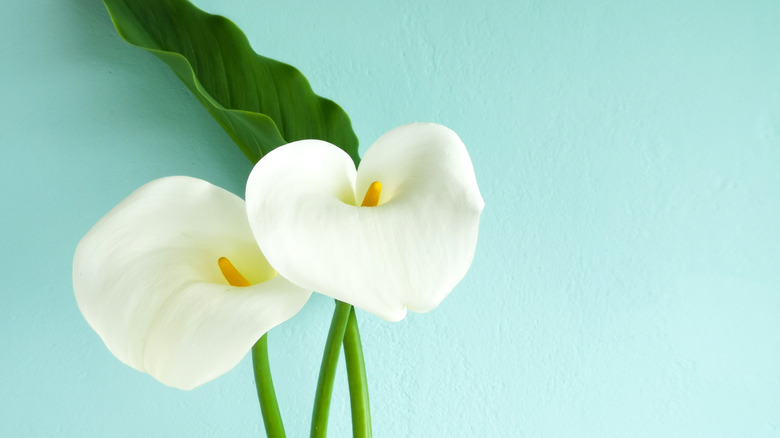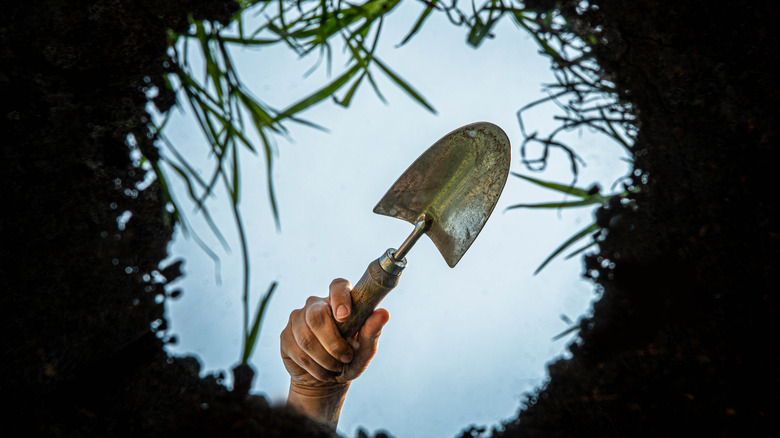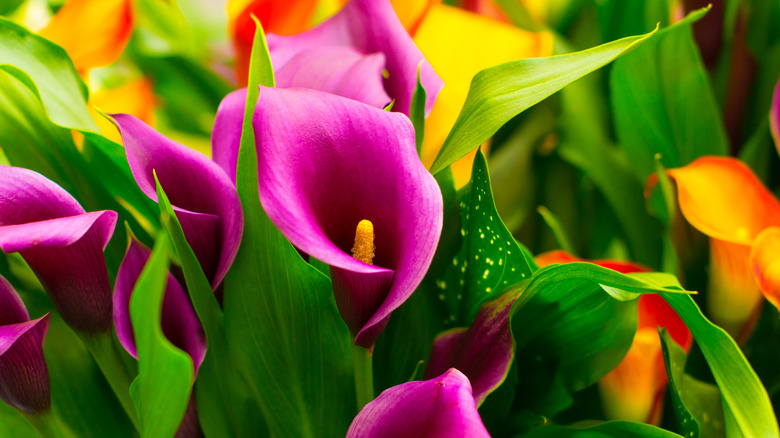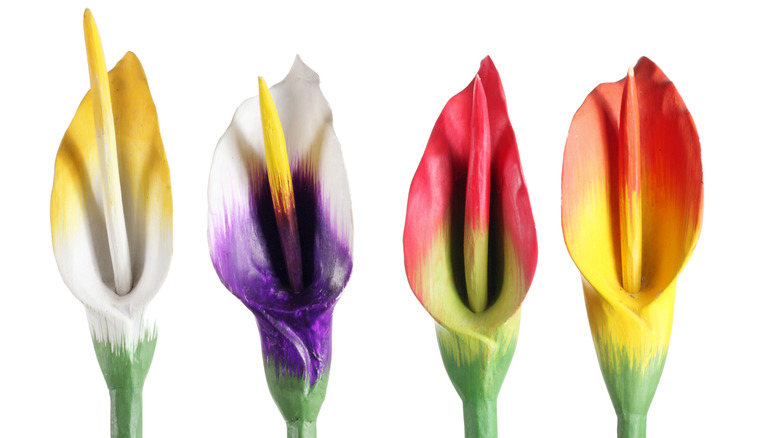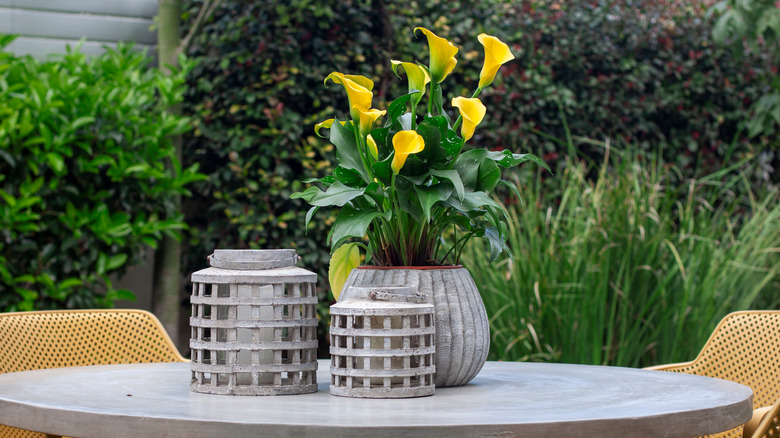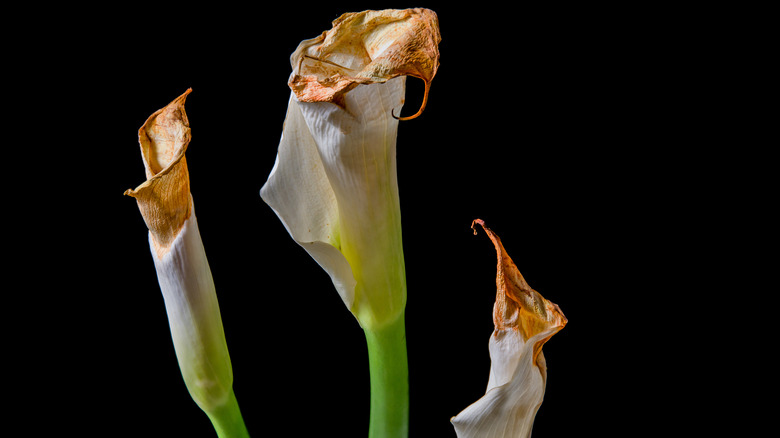Calla Lilies: Everything You Should Know Before Planting
You may recognize Zantedeschia, also known as the calla lily, as a popular wedding flower due to its beautiful white blooms, but did you know that this flower comes in more than one color? The calla lily also grows pink, orange, yellow, lavender, and maroon blooms, all of which add a dizzying array of color to your garden or indoor plant landscape. Calla lilies are a perennial plant that grow to a variety of heights, although most reach between one and three feet, as reported by Pickup Flowers. The petals form a heart shape with a dip at the base where the yellow lamina is located, while the leaves are typically long and curved, reaching around 1.5 feet at the peak of their growth. The uniquely patterned leaves have a white-dotted appearance.
Calla lilies are known around the world for their beauty, and the word calla actually means beautiful in Greek (per Just Fun Facts). The Greeks seem to have a special affinity for calla lilies, and one of the Greek myths involves this flower as well. As the story goes, the Greek god Zeus gave his son, Hercules, to his wife, Hera, to nurse. While she was nursing, several droplets of milk escaped and spread out both into the sky and onto the ground below. Some formed the Milky Way while others became calla lilies. If you're ready for a garden full of these mythical flowers, keep scrolling to learn more about how to grow and care for them.
How to use calla lilies in your garden
If you want a tapestry of these trumpet-like flowers spreading across your garden, you'll be pleased to learn that there are a variety of ways to implement the calla lily into your outdoor landscape. Although calla lilies are most commonly found in white, you can also find them in multiple other colors, which allows you to sprinkle your garden with pops of color. Calla lilies are also a popular cutting flower, which means you can cut a few of the flowers and form them into a bouquet to brighten up your indoor spaces as well, suggests Longfield Gardens. Based on their height, consider planting them around the back border or sides of your garden beds so as not to block the beauty of your other flowers and plants. They will draw the eye without overpowering the space. If you prefer planting your calla lilies in pots and other flower containers, plant them alone. This will also prevent them from overgrowing your garden beds.
The great thing about calla lilies is that they are generally easy-going about where they're planted in your garden as long as you keep them out of direct sunlight and make sure they are in an area with good drainage, according to Easy to Grow Bulbs. Be careful planting near bodies of water but don't be afraid to get creative and use the gorgeous calla lily as a focal point in your landscape.
How to grow calla lilies
Once you've planted your calla lilies, rest assured that you won't need to do too much to keep them alive as long as you've provided the necessary conditions for them to thrive. These conditions include a location with filtered sunlight or shade and soil that doesn't get too saturated and drains easily. When you've determined the ideal location to plant your calla lilies, you will need a trowel to dig into the soil and as many calla lily bulbs as you would like to plant. Remember that calla lilies should be planted in the spring, so save any new bulbs until there is no longer the risk of frost, depending on where you live.
With your trowel, dig holes that measure a few inches deep and then leave roughly a foot of empty space between each bulb to give them enough room to grow, advises Longfield Gardens. When you place the bulb into the soil, identify the part of the bulb where the plant will sprout from, referred to as the "eye." This should be turned toward the sky. For pot- or trough-bound calla lilies, avoid gathering soil from your yard. You'll want to purchase a specialized formula from the store that will provide your calla lilies with proper nutrition. After approximately two weeks, you should see sprouts emerging from the soil. During this time you'll only need to water occasionally, making sure the soil doesn't get too soggy.
How to care for calla lilies
Calla lilies don't require much effort on your part to keep them alive once planted. Easy to Grow Bulbs advises calla lily growers to water no more than one inch per week to avoid harming the plant with too much moisture. Since you've chosen an area of your garden with loose soil or a container with plenty of drainage holes, you won't need to worry about your calla lilies sitting in too much dampness, but you can test the soil throughout the week to make sure it's never bone dry or perpetually soaked. Another important step to take to ensure your calla lilies are taking in enough nutrients is to sprinkle the soil with fertilizer about once a month, as per Gardening Know How. Additionally, keep your garden beds properly mulched. These two steps should be carried out during the times of the year that your calla lilies are actively sprouting new growth.
Your calla lilies will ironically require the most care when they are no longer growing. Depending on the climate where you live, this will be winter (in perennially warm climates, calla lilies can stay planted regardless of time of year). Gardening Know How instructs growers to gently remove calla lilies from the ground when the weather turns in the fall. To ensure they stay alive through the winter, stick them in some peat moss and store in a (dry) basement space. Container-bound calla lilies can simply be brought indoors as is.
Varieties of calla lilies
Calla lilies come in many different varieties and colors and include six species in total (via Gardening Know How). They are native to South Africa and have made their way around the world, brightening floral landscapes for anyone who wants them. Calla lilies grow anywhere from one to three feet, offering a wide range of sizes for different gardening needs. When multiple species and colors are combined, this plant creates a diverse, eye-drawing landscape.
The plain white flower is called Zantedeschia aethiopica, and is a popular element in wedding bouquets and decorations due its representation of marital happiness and fidelity, according to Teleflora. While white is the most common variety, another gorgeous variety of calla lily is the Fire Dancer, which features a gold petal rimmed in red, as described by Gardening Know How. For those in favor of purple flowers, both the Night Life and the Night Cap offer rich violet hues. The Acapulco Gold will brighten anyone's day with its yellow blooms that add summery pops of color to a garden. The Pink Melody is tri-colored with shades of white, pink, and green, and is known for reaching heights of two feet. California Red is another flashy calla lily that features stunning scarlet-rose flower petals. With so many options, you can be sure to find a calla lily variety in your color and size of choice.
Are calla lilies toxic?
Calla lily ingestion should be avoided at all costs as the plant causes a toxic reaction in the mouth and digestive tract, according to SF Gate. All parts of the plant carry a substance known as insoluble calcium oxalate crystals, which cause pain and other unpleasant sensations in the soft tissues of the mouth, throat, and digestive organs. The crystals essentially aggravate these areas as they rub against them, leading to inflammation, hoarseness in the throat, trouble swallowing, and uncontrolled salivation. Some people may even experience vomiting. If you or someone in your family has accidentally ingested any part of a calla lily and is experiencing symptoms associated with poisoning, you can try gargling with chilled water and rinsing out the mouth. Contact emergency medical services in the case of a more critical reaction or if the symptoms persist or don't go away after treating with water.
While not as common, calla lilies can also cause a skin reaction in those sensitive to the plant's secretions. Symptoms include skin discoloration, irritation, blistering, and inflammation. Give the affected area a good cleansing with soap and water in the case of a reaction. If you have pets or young kids, consider planting calla lilies in areas that have restricted access in your garden or confining them to pots that can be stored up high. Alternatively, teach pets and kids to avoid contact with the calla lily plant.
How to repot calla lilies
You may want to repot your calla lily plant because you find that it has outgrown its current container or because you've stored it through the winter and come spring, you need to plant it so that it can flower again. Regardless of the reason, repotting a calla lily is quite simple. You'll want to choose a container that is twice as large as the current one to give the plant adequate room to grow. Remember that proper drainage is of the utmost importance to the health of your calla lily. If your new pot or container doesn't already come with plenty of drainage holes, consider drilling a few more to keep the soil from getting too moist.
You'll know that your calla lily is in desperate need of a new container when the plant becomes what's known as root bound, which means roots have begun growing out of the drainage holes and/or plant growth has stalled, according to Sunday Gardener. Start by placing the plant in the empty pot or container and then fill it with soil until you reach about an inch from the top. You don't need to pack the soil inside the pot. Once repotted, calla lilies need significantly more water than normal. Take care to keep the soil damp until you see that the plant is growing well again. From here on, water as you normally would and add some fertilizer about once a month.
Calla lily pests and diseases
It's important to be aware of pests and diseases that can attack your calla lilies and compromise their health. According to SF Gate, calla lilies can be impacted by a number of different diseases, including bacterial, fungal, and viral. Calla lilies are most affected by rot, which comes in four forms, all brought on by pathogens and bacteria. They include crown rot, soft rot, pythium rot, and root rot. Rot can be avoided by not allowing your calla lilies to sit for excessive periods of time in wet soil. Fungal pathogens thrive on rotting organic matter from other plants and organisms that can build up in your garden or containers and is made worse in overly moist environments. Make sure you are diligently clearing away this debris to avoid pathogens spreading to and targeting your calla lilies.
Calla lilies also suffer from two viruses: spotted wilt and dasheen mosaic. Both viruses make their way onto the plant via insects. Spotted wilt is transmitted through thrips while aphids pass along dasheen mosaic. You'll want to dispose of infected calla lilies so as not to allow the virus to make its way to neighbor plants, and get rid of insect pests on a regular basis to prevent the spread of viruses as well. As thrips and aphids live on weeds, pull up any weeds in your garden whenever they appear. This will make it less likely that these insects will find their way onto your calla lilies.
